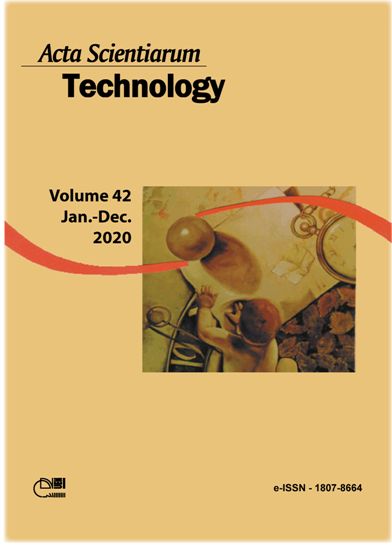Effect of agro-industrial residues mixtures on the production of endoglucanase by Aspergillus niger in solid state fermentation
DOI:
https://doi.org/10.4025/actascitechnol.v42i1.41358Palavras-chave:
solid state fermentation; endoglucanase; experimental mixture design; Aspergillus niger.Resumo
The low-cost production of cellulolytic complexes that present high action at mild conditions is one of the major bottlenecks for the economic viability of the production of cellulosic ethanol. The influence of agro-industrial residues was assessed to enhance endoglucanase production by Aspergillus niger 426 grown in solid state fermentation. The highest percentage of lignin degradation was found on soybean hulls (56%) followed by sugarcane bagasse (36%) and rice straw (8.5%). The cellulose degradation, around 90%, was observed on soybean hulls and sugarcane bagasse, but only 50% on rice straw, and maximum production of endoglucanase (112.34 ± 0.984 U mL-1) was observed for soybean hulls. The best Experimental Mixture Design condition was under cultivation of 2.5 g of sugarcane bagasse, 2.3 g of rice straw and 5.2 g of soybean hulls, leading to a maximum activity of 138.92 ± 0.02 U mL-1. The statistical methodology enabled an increase of over 20% in the production of endoglucanase using agro-industrial waste. These data demonstrate that A. niger 426 is a potential source of cellulases which can be obtained by solid state fermentation using agro-industrial waste.
Downloads
Downloads
Publicado
Como Citar
Edição
Seção
Licença
DECLARAÇíO DE ORIGINALIDADE E DIREITOS AUTORAIS
Declaro que o presente artigo é original, não tendo sido submetido í publicação em qualquer outro periódico nacional ou internacional, quer seja em parte ou em sua totalidade.
Os direitos autorais pertencem exclusivamente aos autores. Os direitos de licenciamento utilizados pelo periódico é a licença Creative Commons Attribution 4.0 (CC BY 4.0): são permitidos o compartilhamento (cópia e distribuição do material em qualqer meio ou formato) e adaptação (remix, transformação e criação de material a partir do conteúdo assim licenciado para quaisquer fins, inclusive comerciais.
Recomenda-se a leitura desse link para maiores informações sobre o tema: fornecimento de créditos e referências de forma correta, entre outros detalhes cruciais para uso adequado do material licenciado.



















